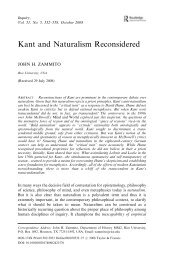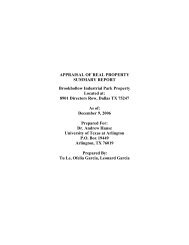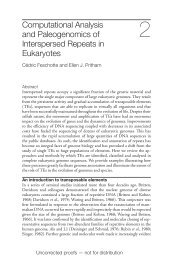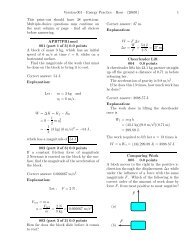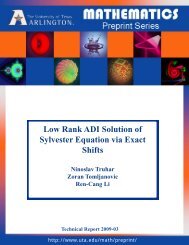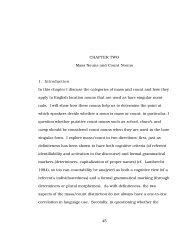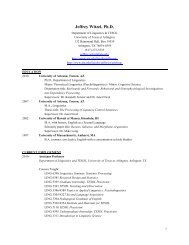The Depth Formula for Modules with Reducible Complexity
The Depth Formula for Modules with Reducible Complexity
The Depth Formula for Modules with Reducible Complexity
You also want an ePaper? Increase the reach of your titles
YUMPU automatically turns print PDFs into web optimized ePapers that Google loves.
<strong>The</strong> <strong>Depth</strong> <strong>Formula</strong> <strong>for</strong><br />
<strong>Modules</strong> <strong>with</strong> <strong>Reducible</strong><br />
<strong>Complexity</strong><br />
Petter Andreas Bergh<br />
David A. Jorgensen<br />
Technical Report 2010-10<br />
http://www.uta.edu/math/preprint/
THE DEPTH FORMULA FOR MODULES WITH REDUCIBLE<br />
COMPLEXITY<br />
PETTER ANDREAS BERGH & DAVID A. JORGENSEN<br />
Abstract. We prove that the depth <strong>for</strong>mula holds <strong>for</strong> Tor-independent modules<br />
in certain cases over a Cohen-Macaulay local ring, provided one of the<br />
modules has reducible complexity.<br />
1. Introduction<br />
Two finitely generated modules M and N over a local ring A satisfy the depth<br />
<strong>for</strong>mula if<br />
(1) depth M + depth N = depth A + depth(M ⊗ A N)<br />
This <strong>for</strong>mula is not at all true in general; an obvious counterexample appears by<br />
taking modules of depth zero over a ring of positive depth. <strong>The</strong> natural question<br />
is then: <strong>for</strong> which pairs of modules does the <strong>for</strong>mula hold? <strong>The</strong> first systematic<br />
treatment of this question was done by Auslander in [Aus], where he considered<br />
the case when one of the modules involved has finite projective dimension. In this<br />
situation, let q be the largest integer such that Tor A q (M, N) is nonzero. Auslander<br />
proved that if either depth Tor A q (M, N) ≤ 1 or q = 0, then the <strong>for</strong>mula<br />
(2) depth M + depth N = depth A + depth Tor A q (M, N) − q<br />
holds. <strong>The</strong> case q = 0 is the depth <strong>for</strong>mula.<br />
Auslander’s result indicated that in order to decide which pairs of modules satisfy<br />
the depth <strong>for</strong>mula, one should concentrate on Tor-independent pairs, that is,<br />
modules M and N satisfying Tor A n (M, N) = 0 <strong>for</strong> n > 0. In [HuW], Huneke and<br />
Wiegand showed that the depth <strong>for</strong>mula holds <strong>for</strong> such modules over complete intersections.<br />
This (and Auslander’s result) was later generalized in [ArY] by Araya<br />
and Yoshino, who considered the case when one of the modules involved has finite<br />
complete intersection dimension. If Tor A n (M, N) = 0 <strong>for</strong> n ≫ 0, let q be the largest<br />
integer such that Tor A q (M, N) is nonzero. In this situation, Araya and Yoshino<br />
proved Auslander’s original result (2) above if either depth Tor A q (M, N) ≤ 1 or<br />
q = 0.<br />
<strong>The</strong> aim of this paper is to investigate the depth <strong>for</strong>mula (1) <strong>for</strong> Tor-independent<br />
modules over a local Cohen-Macaulay ring, provided one of the modules has reducible<br />
complexity. In particular, we show that the <strong>for</strong>mula (1) holds <strong>for</strong> Torindependent<br />
modules over a Cohen-Macaulay ring if one module has reducible<br />
complexity and is not maximal Cohen-Macaulay, or if both modules have reducible<br />
complexity. Moreover, we prove that the depth <strong>for</strong>mula holds if one of the modules<br />
involved has reducible complexity, and the other has finite Gorenstein dimension.<br />
2000 Mathematics Subject Classification. 13C15, 13D02, 13D07, 13D25, 13H10.<br />
Key words and phrases. <strong>Depth</strong> <strong>for</strong>mula, reducible complexity.<br />
1
2 PETTER ANDREAS BERGH & DAVID A. JORGENSEN<br />
In the final section we show that there exist modules having reducible complexity<br />
of any finite complexity, but not finite complete intersection dimension. Knowing<br />
that such modules exist is a critical point of the investigation. <strong>Modules</strong> of infinite<br />
complete intersection dimension are in a precise sense far from resembling those<br />
modules considered in the original explorations of the <strong>for</strong>mulas (1) and (2). Thus<br />
we show that the depth <strong>for</strong>mula holds in a context that is fundamentally departed<br />
from previous considerations. We know of no example of finitely generated Torindependent<br />
modules that do not satisfy the depth <strong>for</strong>mula (1), nor are we aware of a<br />
counterexample to Auslander’s <strong>for</strong>mula (2) when q < ∞, and depth Tor R q (M, N) ≤<br />
1 or q = 0.<br />
2. <strong>Reducible</strong> complexity<br />
Throughout the rest of this paper, we assume that all modules encountered are<br />
finitely generated. In this section, we fix a local (meaning commutative Noetherian<br />
local) ring (A, m, k). Under these assumptions, every A-module M admits a<br />
minimal free resolution<br />
· · · → F 2 → F 1 → F 0 → M → 0<br />
which is unique up to isomorphism. <strong>The</strong> rank of the free A-module F n is the nth<br />
Betti number of M; we denote it by β A n (M). <strong>The</strong> complexity of M, denoted cx M,<br />
is defined as<br />
cx M def<br />
= inf{t ∈ N ∪ {0} | ∃a ∈ R such that β A n (M) ≤ an t−1 <strong>for</strong> all n ≫ 0}.<br />
In other words, the complexity of a module is the polynomial rate of growth of its<br />
Betti sequence. It follows from the definition that cx M = 0 precisely when M has<br />
finite projective dimension, and that cx M = 1 if and only if the Betti sequence<br />
of M is bounded. An arbitrary local ring may have many modules <strong>with</strong> infinite<br />
complexity; by a theorem of Gulliksen (cf. [Gul]), the local rings over which all<br />
modules have finite complexity are precisely the complete intersections.<br />
In [Be1], the concept of modules <strong>with</strong> reducible complexity was introduced.<br />
<strong>The</strong>se are modules which in some sense generalize modules of finite complete intersection<br />
dimension (see [AGP]), in particular modules over complete intersections.<br />
Be<strong>for</strong>e we state the definition, we recall the following. Let M and N be A-modules,<br />
and consider an element η ∈ Ext t A(M, N). By choosing a map f η : Ω t A (M) → N<br />
representing η, we obtain a commutative pushout diagram<br />
0 Ω t A (M) <br />
F t−1<br />
Ω t−1<br />
A (M) 0<br />
f η<br />
0 N K η<br />
Ω t−1<br />
A (M) 0<br />
<strong>with</strong> exact rows. <strong>The</strong> module K η is independent, up to isomorphism, of the map<br />
f η chosen as a representative <strong>for</strong> η. We now recall the definition of modules <strong>with</strong><br />
reducible complexity. Given A-modules X and Y , we denote the graded A-module<br />
⊕ ∞ i=0 Exti A(X, Y ) by Ext ∗ A(X, Y ).<br />
Definition. <strong>The</strong> full subcategory of A-modules consisting of the modules having<br />
reducible complexity is defined inductively as follows:<br />
(i) Every A-module of finite projective dimension has reducible complexity.
THE DEPTH FORMULA FOR MODULES WITH REDUCIBLE COMPLEXITY 3<br />
(ii) An A-module M of finite positive complexity has reducible complexity if<br />
there exists a homogeneous element η ∈ Ext ∗ A(M, M), of positive degree,<br />
such that cx K η < cx M and K η has reducible complexity.<br />
Thus, an A-module M of finite positive complexity c, say, has reducible complexity<br />
if and only if the following hold: there exist nonnegative integers n 1 , . . . , n t ,<br />
<strong>with</strong> t ≤ c, and exact sequences (<strong>with</strong> K 0 = M)<br />
η 1 : 0 K 0<br />
K 1<br />
Ω n1<br />
A (K 0) 0<br />
.<br />
.<br />
.<br />
η t : 0 K t−1<br />
K t<br />
Ω nt<br />
A (K t−1) 0<br />
in which cx M > cx K 1 > · · · > cx K t = 0. We say that these sequences η 1 , . . . , η t<br />
reduce the complexity of M. As shown in [Be1], every module of finite complete<br />
intersection dimension has reducible complexity. In particular, if A is a complete<br />
intersection, then every A-module has this property.<br />
Remark 1. In the original definition in [Be1], the extra requirement depth M =<br />
depth K 1 = · · · = depth K t was included. However, as we will only be working over<br />
Cohen-Macaulay rings, this requirement is redundant. Namely, when A is Cohen-<br />
Macaulay and M is any A-module, then the depth of any syzygy of M is at least<br />
the depth of M. Consequently, in a short exact sequence<br />
0 → M → K → Ω n A(M) → 0<br />
the depth of M automatically equals that of K.<br />
3. <strong>The</strong> depth <strong>for</strong>mula<br />
Let A be a local ring, and let M be an A-module <strong>with</strong> reducible complexity. If<br />
the complexity of M is positive, then by definition there exist a number t and short<br />
exact sequences<br />
η i : 0 → K i−1 → K i → Ω |ηi|−1<br />
A<br />
(K i−1 ) → 0<br />
<strong>for</strong> 1 ≤ i ≤ t reducing the complexity of M. We define the upper reducing degree<br />
of M, denoted reddeg ∗ M, to be the supremum of the minimal degree of the cohomological<br />
elements η i , the supremum taken over all such sequences reducing the<br />
complexity of M:<br />
reddeg ∗ M def<br />
= sup{min{|η 1 |, . . . , |η t |} | η 1 , . . . , η t reduces the complexity of M}.<br />
If the complexity of M is zero, that is, if M has finite projective dimension, then<br />
we define reddeg ∗ M = ∞. Note that the inequality reddeg ∗ M ≥ 1 always holds.<br />
We now prove our first result, namely the depth <strong>for</strong>mula in the situation when<br />
the tensor product of the two modules involved has depth zero. In this result, we<br />
also include a generalized version of half of [ArY, <strong>The</strong>orem 2.5].<br />
<strong>The</strong>orem 3.1. Let A be a Cohen-Macaulay local ring, and let M and N be nonzero<br />
A-modules such that M has reducible complexity. Suppose that Tor A n (M, N) =<br />
0 <strong>for</strong> n ≫ 0, and let q be the largest integer such that Tor A q (M, N) is nonzero.<br />
Furthermore, suppose that one of the following holds:<br />
(i) depth Tor A q (M, N) = 0,
4 PETTER ANDREAS BERGH & DAVID A. JORGENSEN<br />
(ii) q ≥ 1, depth Tor A q (M, N) ≤ 1 and reddeg ∗ M ≥ 2.<br />
<strong>The</strong>n the <strong>for</strong>mula<br />
holds.<br />
depth M + depth N = dim A + depth Tor A q (M, N) − q<br />
Proof. Part (i) is just [Be1, <strong>The</strong>orem 3.4(i)], so we only need to prove (ii). We do<br />
this by induction on the complexity of M, where the case cx M = 0 follows from<br />
Auslander’s original result [Aus, <strong>The</strong>orem 1.2]. Suppose there<strong>for</strong>e the complexity<br />
of M is nonzero. Since reddeg ∗ M ≥ 2, there exists an exact sequence<br />
0 → M → K → Ω n A(M) → 0<br />
<strong>with</strong> n ≥ 1, in which the complexity of K is at most cx M − 1 and reddeg ∗ K ≥ 2.<br />
From this sequence we see that Tor A q (K, N) is isomorphic to Tor A q (M, N), and that<br />
Tor A i (K, N) = 0 <strong>for</strong> i ≥ q + 1. <strong>The</strong> <strong>for</strong>mula there<strong>for</strong>e holds <strong>with</strong> K replacing M,<br />
but since depth K = depth M we are done.<br />
□<br />
As mentioned, the proof of this result generalizes the first half of [ArY, <strong>The</strong>orem<br />
2.5]. Namely, if A is a local ring (not necessarily Cohen-Macaulay) and M is a<br />
module of finite complete intersection dimension, then M has reducible complexity<br />
(including the depth condition of Remark 1) by [Be1, Proposition 2.2(i)], and<br />
reddeg ∗ M = ∞ by [Be2, Lemma 2.1(ii)].<br />
Next, we show that the depth <strong>for</strong>mula is valid <strong>for</strong> Tor-independent modules<br />
over a local Cohen-Macaulay ring in the following situation: one of the modules<br />
has reducible complexity, and the other has finite Gorenstein dimension. Recall<br />
there<strong>for</strong>e that if A is a local ring, then a module M has Gorenstein dimension<br />
zero if the following hold: the module is reflexive (i.e. the canonical homomorphism<br />
M → Hom A (Hom A (M, A), A) is bijective), and<br />
Ext n A(M, A) = 0 = Ext n A(Hom A (M, A), A)<br />
<strong>for</strong> all n > 0. <strong>The</strong> Gorenstein dimension of M is defined to be the infimum of all<br />
nonnegative integers n, such that there exists an exact sequence<br />
0 → G n → · · · → G 0 → M → 0<br />
in which all the G i have Gorenstein dimension zero. By [AuB, <strong>The</strong>orem 4.13], if M<br />
has finite Gorenstein dimension, then it equals depth A − depth M. Moreover, by<br />
[AuB, <strong>The</strong>orem 4.20], a local ring is Gorenstein precisely when every module has<br />
finite Gorenstein dimension.<br />
Proposition 3.2. Let A be a local Cohen-Macaulay ring, and M and N be nonzero<br />
Tor-independent A-modules. Assume that M is maximal Cohen-Macaulay and<br />
has reducible complexity, and that N has finite Gorenstein dimension. <strong>The</strong>n if<br />
depth(M ⊗ A N) is nonzero, so is depth N.<br />
Proof. By [CFH, Lemma 2.17], there exists an exact sequence<br />
0 → N → I → X → 0<br />
in which the projective dimension of I is finite and X has Gorenstein dimension<br />
zero. <strong>The</strong>n Tor A n (M, I) and Tor A n (M, X) both vanish <strong>for</strong> n ≫ 0, and since M is<br />
maximal Cohen-Macaulay it follows from [Be1, <strong>The</strong>orem 3.3] that Tor A n (M, I) =<br />
0 = Tor A n (M, X) <strong>for</strong> n ≥ 1. Hence the pairs (M, N), (M, I) and (M, X) are all<br />
Tor-independent.
THE DEPTH FORMULA FOR MODULES WITH REDUCIBLE COMPLEXITY 5<br />
Suppose depth N = 0. <strong>The</strong>n the depth of I is also zero. Tensoring the exact<br />
sequence <strong>with</strong> M yields the exact sequence<br />
0 → M ⊗ A N → M ⊗ A I → M ⊗ A X → 0.<br />
By Auslander’s original result, the depth <strong>for</strong>mula holds <strong>for</strong> the pair (M, I). Moreover,<br />
by [Be1, <strong>The</strong>orem 3.4(iii)], the <strong>for</strong>mula also holds <strong>for</strong> the pair (M, X), hence<br />
depth M + depth I = dim A + depth(M ⊗ A I)<br />
and<br />
depth M + depth X = dim A + depth(M ⊗ A X).<br />
<strong>The</strong> first of these <strong>for</strong>mulas implies that the depth of M ⊗ A I is zero. <strong>The</strong> second<br />
<strong>for</strong>mula, together <strong>with</strong> the fact that X is maximal Cohen-Macaulay, implies that<br />
M ⊗ A X is maximal Cohen-Macaulay. <strong>The</strong>re<strong>for</strong>e depth(M ⊗ A N) = 0 by the depth<br />
lemma.<br />
□<br />
We can now prove that the depth <strong>for</strong>mula holds when one module has reducible<br />
complexity, and the other has finite Gorenstein dimension.<br />
<strong>The</strong>orem 3.3 (<strong>Depth</strong> <strong>for</strong>mula - Gorenstein case 1). Let A be a local Cohen-<br />
Macaulay ring, and M and N be nonzero Tor-independent A-modules. If M has<br />
reducible complexity and N has finite Gorenstein dimension, then<br />
depth M + depth N = dim A + depth(M ⊗ A N).<br />
Proof. We prove this result by induction on the depth of the tensor product. If<br />
depth(M ⊗ A N) = 0, then the <strong>for</strong>mula holds by <strong>The</strong>orem 3.1, so assume that<br />
depth(M ⊗ A N) is positive. If M has finite projective dimension, then the <strong>for</strong>mula<br />
holds by Auslander’s original result, hence we assume that the complexity of M is<br />
positive.<br />
Suppose the depth of N is zero. Choose short exact sequences (<strong>with</strong> K 0 = M)<br />
0 K 0<br />
K 1<br />
Ω n1<br />
A (K 0) 0<br />
.<br />
.<br />
.<br />
0 K t−1<br />
K t<br />
Ω nt<br />
A (K t−1) 0<br />
reducing the complexity of M, and note that the pair (K i , N) is Tor-independent<br />
<strong>for</strong> all i. Since the projective dimension of K t is finite, the depth <strong>for</strong>mula holds <strong>for</strong><br />
K t and N, i.e.<br />
depth K t + depth N = dim A + depth(K t ⊗ A N).<br />
Since depth N = 0, we see that K t , and hence also M, is maximal Cohen-Macaulay.<br />
But this contradicts Proposition 3.2, hence the depth of N must be positive.<br />
Choose an element x ∈ A which is regular on both N and M ⊗ A N. Tensoring<br />
the exact sequence<br />
0 → N −→ ·x<br />
N → N/xN → 0<br />
<strong>with</strong> M, we get the exact sequence<br />
0 → Tor A 1 (M, N/xN) → M ⊗ A N ·x<br />
−→ M ⊗ A N → M ⊗ A N/xN → 0.<br />
We also see that Tor A n (M, N/xN) = 0 <strong>for</strong> n ≥ 2. However, the element x is<br />
regular on M ⊗ A N, hence Tor A 1 (M, N/xN) = 0 and (M ⊗ A N)/x(M ⊗ A N) ≃
6 PETTER ANDREAS BERGH & DAVID A. JORGENSEN<br />
M ⊗ A N/xN. <strong>The</strong> modules M and N/xN are there<strong>for</strong>e Tor-independent, and<br />
depth(M ⊗ A N/xN) = depth(M ⊗ A N) − 1. By induction, the depth <strong>for</strong>mula holds<br />
<strong>for</strong> M and N/xN, giving<br />
depth M + depth N = depth M + depth N/xN + 1<br />
This concludes the proof.<br />
= dim A + depth(M ⊗ A N/xN) + 1<br />
= dim A + depth(M ⊗ A N).<br />
Corollary 3.4 (<strong>Depth</strong> <strong>for</strong>mula - Gorenstein case 2). Let A be a Gorenstein local<br />
ring, and M and N be nonzero Tor-independent A-modules. If M has reducible<br />
complexity, then<br />
depth M + depth N = dim A + depth(M ⊗ A N).<br />
Remark. In work in progress by Lars Winther Christensen and the second author<br />
(cf. [ChJ]), the depth <strong>for</strong>mula is proved <strong>for</strong> modules M and N over a local ring A<br />
under the following assumptions: the module M has finite Gorenstein dimension,<br />
and the Tate homology group ̂Tor A n (M, N) vanishes <strong>for</strong> all n ∈ Z.<br />
What can we say if the ring is not necessarily Gorenstein, or, more general,<br />
when we do not assume that one of the modules has finite Gorenstein dimension?<br />
<strong>The</strong> following result shows that if the ring is Cohen-Macaulay and the module having<br />
reducible complexity is not maximal Cohen-Macaulay, then the depth <strong>for</strong>mula<br />
holds.<br />
<strong>The</strong>orem 3.5 (<strong>Depth</strong> <strong>for</strong>mula - Cohen-Macaulay case 1). Let A be a Cohen-<br />
Macaulay local ring, and let M and N be nonzero Tor-independent A-modules.<br />
If M has reducible complexity and is not maximal Cohen-Macaulay, then<br />
depth M + depth N = dim A + depth(M ⊗ A N).<br />
Proof. We prove this result by induction on the complexity of M. As be<strong>for</strong>e, if M<br />
has finite projective dimension, then the depth <strong>for</strong>mula follows from Auslander’s<br />
original result. We there<strong>for</strong>e assume that the complexity of M is positive.<br />
Choose a short exact sequence<br />
0 → M → K → Ω t A(M) → 0<br />
in Ext t A(M, M), <strong>with</strong> cx K < cx M and t ≥ 0. Since M and K are Tor-independent<br />
and depth K = depth M, the depth <strong>for</strong>mula holds <strong>for</strong> these modules by induction,<br />
i.e.<br />
(†) depth K + depth N = dim A + depth(K ⊗ A N).<br />
<strong>The</strong>re<strong>for</strong>e, we need only to show that depth(K ⊗ A N) = depth(M ⊗ A N).<br />
If t = 0, then by tensoring the above exact sequence <strong>with</strong> N, we obtain the exact<br />
sequence<br />
0 → M ⊗ A N → K ⊗ A N → M ⊗ A N → 0.<br />
In this situation, the equality depth(K ⊗ A N) = depth(M ⊗ A N) follows from the<br />
depth lemma, and we are done. What remains is there<strong>for</strong>e the case t ≥ 1. Moreover,<br />
by considering the short exact sequence<br />
(††) 0 → M ⊗ A N → K ⊗ A N → Ω t A(M) ⊗ A N → 0,<br />
□
THE DEPTH FORMULA FOR MODULES WITH REDUCIBLE COMPLEXITY 7<br />
we see that if the depth of M ⊗ A N is zero, then so is the depth of K ⊗ A N. In<br />
this case we are done, hence we may assume that the depth of M ⊗ A N is positive.<br />
Suppose depth(K ⊗ A N) > depth(M ⊗ A N). <strong>The</strong>n depth(Ω t A (M) ⊗ A N) =<br />
depth(M ⊗ A N) − 1 by the depth lemma. Now <strong>for</strong> each i ≥ 1, let<br />
0 → Ω i+1<br />
A (M) → Aβi → Ω i A(M) → 0<br />
be a projective cover of Ω i A (M), and note that this sequence stays exact when we<br />
tensor <strong>with</strong> N. Let s be the largest integer in {0, . . . , t − 1} such that in the exact<br />
sequence<br />
(† † †) 0 → Ω s+1<br />
A (M) ⊗ A N → N βs → Ω s A(M) ⊗ A N → 0<br />
the inequality depth(Ω s+1<br />
A (M) ⊗ A N) < depth(Ω s A (M) ⊗ A N) holds. From the<br />
depth lemma applied to this sequence, we see that<br />
depth N = depth(Ω s+1<br />
A (M) ⊗ A N)<br />
≤ depth(Ω t A(M) ⊗ A N)<br />
= depth(M ⊗ A N) − 1<br />
< depth(K ⊗ A N) − 1.<br />
But then from (†) we obtain the contradiction dim A < depth K − 1, and consequently<br />
the inequality depth(K ⊗ A N) > depth(M ⊗ A N) cannot hold.<br />
Next, suppose that depth(K ⊗ A N) < depth(M ⊗ A N). Applying the depth<br />
lemma to (††), we see that depth(K ⊗ A N) = depth(Ω t A (M) ⊗ A N). Again,<br />
let s be the largest integer in {0, . . . , t − 1} such that depth(Ω s+1<br />
A (M) ⊗ A N) <<br />
depth(Ω s A (M) ⊗ A N). <strong>The</strong>n the depth lemma applied to († † †) gives<br />
depth N = depth(Ω s+1<br />
A (M) ⊗ A N)<br />
≤ depth(Ω t A(M) ⊗ A N)<br />
= depth(K ⊗ A N).<br />
From (†) it now follows that K, and hence also M, is maximal Cohen-Macaulay, a<br />
contradiction. This shows that the depth of K ⊗ A N equals that of M ⊗ A N. □<br />
Next, we show that if both the Tor-independent modules have reducible complexity,<br />
then the depth <strong>for</strong>mula holds <strong>with</strong>out the assumption that M is not maximal<br />
Cohen-Macaulay.<br />
<strong>The</strong>orem 3.6 (<strong>Depth</strong> <strong>for</strong>mula - Cohen-Macaulay case 2). Let A be a Cohen-<br />
Macaulay local ring, and let M and N be nonzero Tor-independent A-modules.<br />
If both M and N have reducible complexity, then<br />
depth M + depth N = dim A + depth(M ⊗ A N).<br />
Proof. If one of the modules is not maximal Cohen-Macaulay, the result follows<br />
from <strong>The</strong>orem 3.5. If not, then the result follows from [Be1, <strong>The</strong>orem 3.4(iii)]. □<br />
What happens over a Cohen-Macaulay ring if we only require that one of the<br />
modules has reducible complexity? We end this section <strong>with</strong> the following result,<br />
showing that, in this situation, if the depth of the tensor product is nonzero, then<br />
so is the depth of the module having reducible complexity.<br />
Proposition 3.7. Let A be a Cohen-Macaulay local ring, and let M and N be<br />
nonzero Tor-independent A-modules such that M has reducible complexity. <strong>The</strong>n if<br />
depth(M ⊗ A N) is nonzero, so is depth M.
8 PETTER ANDREAS BERGH & DAVID A. JORGENSEN<br />
Proof. If M is maximal Cohen-Macaulay, then the result trivially holds. If not,<br />
then the depth <strong>for</strong>mula holds by <strong>The</strong>orem 3.5, i.e.<br />
depth M + depth N = dim A + depth(M ⊗ A N).<br />
Thus, if the depth of (M ⊗ A N) is nonzero, then so is depth M.<br />
4. <strong>Modules</strong> <strong>with</strong> reducible complexity and inifinite complete<br />
intersection dimension<br />
We shall shortly give examples showing that there exist modules having reducible<br />
complexity of any finite complexity, but not finite complete intersection dimension.<br />
In order to do this, we opt to work <strong>with</strong> complexes in the derived category D(A)<br />
of A-modules. This is a triangulated category, the suspension functor Σ being the<br />
left shift of a complex together <strong>with</strong> a sign change in the differential. Now let<br />
C : · · · → C n+1 → C n → C n−1 → · · ·<br />
be a complex in D(A). <strong>The</strong>n C is bounded below if C n = 0 <strong>for</strong> n ≪ 0, and<br />
bounded above if C n = 0 <strong>for</strong> n ≫ 0. <strong>The</strong> complex is bounded if it is both bounded<br />
below and bounded above. <strong>The</strong> homology of C, denoted H(C), is the complex<br />
<strong>with</strong> H(C) n = H n (C), and <strong>with</strong> trivial differentials. When H(C) is bounded and<br />
degreewise finitely generated, then C is said to be homologically finite. We denote<br />
the full subcategory of homologically finite complexes by D hf (A).<br />
When C is homologically finite, it has a minimal free resolution (cf. [Rob]). Thus,<br />
there exists a quasi-isomorphism F ≃ C, where F is a bounded below complex<br />
d n+1 d<br />
· · · → F n+1 −−−→<br />
n<br />
Fn −→ Fn−1 → · · ·<br />
of finitely generated free A-modules, and where Im d n ⊆ m F n−1 . <strong>The</strong> minimal free<br />
resolution is unique up to isomorphism, and so <strong>for</strong> each integer n the rank of the<br />
free module F n is a well defined invariant of C. Thus we may define Betti numbers<br />
and complexity <strong>for</strong> homologically finite complexes, and also the concept of reducible<br />
complexity. A complex C ∈ D hf (A) is said to have finite project dimension if it is<br />
quasi-isomorphic to a perfect complex.<br />
Definition. <strong>The</strong> full subcategory of complexes in D hf (A) having reducible complexity<br />
is defined inductively as follows:<br />
(i) Every homologically finite complex of finite projective dimension has reducible<br />
complexity.<br />
(ii) A homologically finite complex C of finite positive complexity has reducible<br />
complexity if there exists a triangle<br />
C → Σ n C → K → Σ C<br />
<strong>with</strong> n > 0, such that cx K < cx C and K has reducible complexity.<br />
<strong>The</strong> Betti numbers (and hence also the complexity) of an A-module M equal the<br />
Betti numbers of M viewed as an element in D(A), i.e. as the stalk complex<br />
· · · → 0 → 0 → M → 0 → 0 → · · ·<br />
<strong>with</strong> M concentrated in degree zero. Moreover, the module M has reducible complexity<br />
if and only if it has reducible complexity in D(A). To see this, let<br />
η : 0 → M → K → Ω n−1<br />
A (M) → 0<br />
□
THE DEPTH FORMULA FOR MODULES WITH REDUCIBLE COMPLEXITY 9<br />
be a short exact sequence, and let F be a free resolution of M. <strong>The</strong>n η corresponds<br />
to a map F → Σ n F in D(A) whose cone is a free resolution of K. Thus a sequence<br />
of short exact sequences of modules (<strong>with</strong> K 0 = M)<br />
0 K 0<br />
K 1<br />
Ω n1−1<br />
A<br />
(K 0 ) 0<br />
.<br />
.<br />
.<br />
0 K t−1<br />
K t<br />
Ω nt−1<br />
A<br />
(K t−1 ) 0<br />
reducing the complexity of M, corresponds to a sequence of triangles<br />
F (K 0 ) Σ n1 F (K 0 ) F (K 1 ) Σ F (K 0 )<br />
.<br />
.<br />
.<br />
.<br />
F (K t−1 ) Σ nt F (K t−1 ) F (K t ) Σ F (K t−1 )<br />
reducing the complexity of F , <strong>with</strong> F (K i ) a free resolution of K i . Conversely, every<br />
such sequence of triangles of free resolutions of K i gives a sequence of short exact<br />
sequences reducing the complexity of M.<br />
<strong>The</strong>re is more generally a relation between homologically finite complexes of<br />
reducible complexity and modules of reducible complexity. For a complex C in<br />
D hf (A) we define the supremum of C to be<br />
sup(C) = sup{i| H i (C) ≠ 0}.<br />
Proposition 4.1. Let C ∈ D hf (A) be a complex <strong>with</strong> reducible complexity and<br />
n = sup(C). <strong>The</strong>n the A-module M = Coker(C n+1 → C n ) has reducible complexity.<br />
Proof. We may assume that C is a minimal complex of finitely generated free A-<br />
modules. Let F = C ≥n . <strong>The</strong>n F is a minimal free resolution of M. Moreover, it is<br />
easy to check that F has reducible complexity since C has. Thus by the discussion<br />
above, M has reducible complexity.<br />
□<br />
We say that a complex C ∈ D hf (A) has finite CI-dimension if there exists a<br />
diagram of local ring homomorphisms A → R ← Q <strong>with</strong> A → R flat and R ← Q<br />
surjective <strong>with</strong> kernel generated by a regular sequence, such that R ⊗ A C has finite<br />
projective dimension as a complex of Q-modules (cf. [S-W]).<br />
<strong>The</strong>re is a connection between finite CI-dimension of a complex and that of a<br />
module.<br />
Proposition 4.2. Let C be in D hf (A). If Coker(C n+1 → C n ) has finite CIdimension<br />
<strong>for</strong> some n ≥ sup(C), then so does C.<br />
Proof. We may assume that C is a minimal complex of finitely generated free A-<br />
modules. <strong>The</strong> result is then [S-W, Corollary 3.8].<br />
□<br />
<strong>The</strong> following is an easy fact whose proof is left as an exercise.<br />
Proposition 4.3. Let 0 → Y → X → Σ n X → 0 be a short exact sequence of<br />
complexes in D hf (A). <strong>The</strong>n Y has finite CI dimension if X does.
10 PETTER ANDREAS BERGH & DAVID A. JORGENSEN<br />
Construction 4.4. Let k be a field and A (i) be k-algebras <strong>for</strong> 1 ≤ i ≤ c. Furthermore,<br />
<strong>for</strong> each 1 ≤ i ≤ c let F (i) be a complex of finitely generated free A (i) -modules<br />
<strong>with</strong> F (i)<br />
j = 0 <strong>for</strong> j < 0, and possessing a surjective chain map η (i) : F (i) → Σ ni F (i)<br />
of degree n i . <strong>The</strong>n<br />
F = F (1) ⊗ k · · · ⊗ k F (c)<br />
is a complex of finitely generated free A = A (1) ⊗ k · · · ⊗ k A (c) -modules <strong>with</strong> F j = 0<br />
<strong>for</strong> j < 0, and each η (i) induces a surjective chain map ¯η (i) : F → Σ ni F . Moreover<br />
the ¯η (i) commute <strong>with</strong> one another.<br />
Let C(¯η (1) ) denote the cone of ¯η (1) . <strong>The</strong>n since η (1) and η (2) commute <strong>with</strong> one<br />
another, ¯η (2) induces a surjective chain map C(¯η (1) ) → Σ n2 C(¯η (1) ). By abuse of<br />
notation we let C(¯η (2) ) denote the cone of this chain map. Inductively we define<br />
C(¯η (i) ) to be the cone of the surjective chain map on C(¯η (i−1) ) induced by ¯η (i) .<br />
When η (i)<br />
j is an isomorphism <strong>for</strong> j ≥ n i , and no such chain map exists of degree<br />
less than n i , we say that F (i) is periodic of period n i .<br />
Proposition 4.5. With the notation above, assume that A is local. Suppose that<br />
each F (i) is periodic of period n i , <strong>with</strong> η i : F (i) → Σ ni F (i) being the surjective<br />
endomorphism defining the periodicity of F (i) . <strong>The</strong>n F has reducible complexity<br />
and complexity c.<br />
Proof. By the discussion above we have a sequence of triangles<br />
F Σ n1 F C(¯η (1) ) Σ F<br />
.<br />
.<br />
.<br />
.<br />
C(¯η (c−1) ) Σ nc C(¯η (c−1) ) C(¯η (c) ) Σ C(¯η (c−1) )<br />
Since each chain map induced by ¯η (i) , 1 ≤ i ≤ c, is onto, the complexity of each<br />
C(¯η (i) ) is one less than that of C(¯η (i−1) ).<br />
□<br />
Assume that each F (i) is periodic. Define <strong>for</strong> 0 ≤ i ≤ c the complexes<br />
E (i) = F (1)<br />
2. It is well-known<br />
that complexes of finite CI-dimension and complexity one are periodic of period<br />
≤ 2. Thus E (c−1) has infinite CI-dimension, and there<strong>for</strong>e so does F . □<br />
<strong>The</strong> following corollary is the main point of this section. Its proof follows from<br />
the previous results.
THE DEPTH FORMULA FOR MODULES WITH REDUCIBLE COMPLEXITY 11<br />
Corollary 4.7. Assume that A is local, and that F is defined as in Proposition 4.6,<br />
<strong>with</strong> n i = 1 <strong>for</strong> 1 ≤ i ≤ c−1 and n c > 2. <strong>The</strong>n the A-module M = Coker(F 1 → F 0 )<br />
has reducible complexity c and infinite CI-dimension.<br />
Remark. <strong>The</strong> hypothesis in 4.5 and 4.7, that A be local, is easy to achieve. Indeed,<br />
one could take each k-algebra A (i) to be local and artinian. <strong>The</strong>n the same holds<br />
<strong>for</strong> A. Examples of complexes F (i) of complexity one, both periodic of arbitrary<br />
period, and aperiodic are well-known to exist over local artinian rings. See, <strong>for</strong><br />
example [GP].<br />
In the spirit of Section 3, one would also like to know that there exist modules of<br />
reducible complexity c and infinite CI-dimension over rings A of positive dimension.<br />
<strong>The</strong>se are easily seen to exist by taking de<strong>for</strong>mations of examples such as above.<br />
For instance, if A is local artinian and M is an A-module of reducible complexity<br />
c and infinite CI-dimension, then <strong>for</strong> indeterminates x 1 , . . . , x r , let A ′ be the ring<br />
A[x 1 , . . . , x r ] suitable localized, and M ′ the A ′ -module M[x 1 , . . . , x r ] similarly localized.<br />
<strong>The</strong>n M ′ has the same properties as M, now over the positive dimensional<br />
local ring A ′ . This same conclusion holds too if one reduces both A ′ and M ′ by a<br />
regular sequence in the maximal ideal of A ′ .<br />
Acknowledgements<br />
This work was done while the second author was visiting Trondheim, Norway,<br />
August 2009. He thanks the Algebra Group at the Institutt <strong>for</strong> Matematiske Fag,<br />
NTNU, <strong>for</strong> their hospitality and generous support. <strong>The</strong> first author was supported<br />
by NFR Stor<strong>for</strong>sk grant no. 167130.<br />
References<br />
[Aus] M. Auslander, <strong>Modules</strong> over unramified regular local rings, Ill. J. Math. 5 (1961), no. 4,<br />
631-647.<br />
[AuB] M. Auslander, M. Bridger, Stable module theory, Mem. Amer. Math. Soc. 94 (1969).<br />
[AGP] L. Avramov, V. Gasharov, I. Peeva, Complete intersection dimension, Publ. Math.<br />
I.H.E.S. 86 (1997), 67-114.<br />
[ArY] T. Araya, Y. Yoshino, Remarks on a depth <strong>for</strong>mula, a grade inequality and a conjecture<br />
of Auslander, Comm. Algebra 26 (1998), 3793-3806.<br />
[Be1] P.A. Bergh, <strong>Modules</strong> <strong>with</strong> reducible complexity, J. Algebra 310 (2007), 132-147.<br />
[Be2] P.A. Bergh, On the vanishing of (co)homology over local rings, J. Pure Appl. Algebra 212<br />
(2008), no. 1, 262-270.<br />
[CFH] L.W. Christensen, A. Frankild, H. Holm, On Gorenstein projective, injective and flat<br />
dimensions - A functorial description <strong>with</strong> applications, J. Algebra 302 (2006), 231-279.<br />
[ChJ] L.W. Christensen, D. Jorgensen, Totally acyclic complexes and the depth <strong>for</strong>mula, in<br />
progress.<br />
[GP] V. Gasharov and I. Peeva, Boundedness versus periodicity over commutative local rings,<br />
Trans. Amer. Math. Soc. 320 (1990), 569–580.<br />
[Gul] T.H. Gulliksen, On the deviations of a local ring, Math. Scand. 47 (1980), no. 1, 5-20.<br />
[HuW] C. Huneke, R. Wiegand, Tensor products of modules and the rigidity of Tor, Math. Ann.<br />
299 (1994), 449-476.<br />
[Rob] P. Roberts, Homological invariants of modules over commutative rings, Séminaire de<br />
Mathématiques Supérieures [Seminar on Higher Mathematics], 72, Presses de l’Université<br />
de Montréal, Montreal, Que., 1980.<br />
[S-W] S. Sather-Wagstaff, Complete intersection dimensions <strong>for</strong> complexes, J. Pure Appl. Algebra<br />
190 (2004), no. 1-3, 267-290.
12 PETTER ANDREAS BERGH & DAVID A. JORGENSEN<br />
Petter Andreas Bergh, Institutt <strong>for</strong> matematiske fag, NTNU, N-7491 Trondheim,<br />
Norway<br />
E-mail address: bergh@math.ntnu.no<br />
David A. Jorgensen, Department of mathematics, University of Texas at Arlington,<br />
Arlington, TX 76019, USA<br />
E-mail address: djorgens@uta.edu



